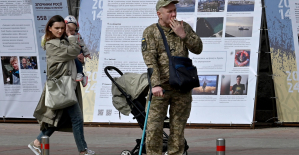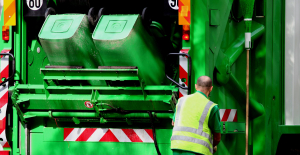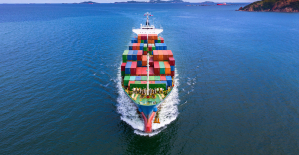It was 5:25 a.m. this Tuesday, April 9, when the Twitter account for line 1 announced that traffic was interrupted between Charles de Gaulle-Etoile and Esplanade de la Défense, due to an “operating incident” that occurred at Porte Maillot . A rather vague message for regular users of public transport in the Ile-de-France region, who have just understood that they will have to be patient. Here is a short glossary to help you see things more clearly:
“An “operational incident” is a generic term used in passenger information at the start of an incident (...) the time to have more precise information on the cause of the disruption”, concedes the RATP, which recognizes that “this term can, therefore, refer to any type of incident: emergency braking, serious passenger accident, suspicious package…”. However, there are many different disturbance patterns, a true “standardized pattern library”. Here are the most common:
The breakdown on the installations “concerns malfunctions in the infrastructure or incidents external to the network manager which impact the infrastructure”.
The most common, signaling failure, forces the driver to stop the movement of his train. Far from being “breakdowns” strictly speaking, these malfunctions are often linked to signal anomalies. But in the same way, it could be a switch failure, which could result from a piece of ballast or other object stuck in the switch system.
This means that the rail carrier “waits for authorizations from the network manager to run its trains”. A wait which may be due to “regulatory measures of other carriers on the same infrastructure, other late trains or even travelers holding back the doors”.
A behavior “which disrupts train traffic”, underlines SNCF Transilien, which specifies that this wait for authorization can entirely be “internal or external” to the railway transport companies and infrastructure managers.
From “simple” discomfort to cardiac arrest, traveler’s illness can cause major disruptions on the Ile-de-France network. In 98% of cases, according to the carriers, they are benign. However, they are the leading cause of delays in the RER, with more than 700 trains blocked per year, and 3.4 million travelers delayed.
Big news this year: the protocol for managing traveler illness has been completely redesigned, and should be deployed this summer. Until then, victims of discomfort should not be manipulated, and therefore remained where they were failing. Except that their treatment could take up to 45 minutes, and immobilize a train if the sick person was inside. From now on, a “Samu protocol” will take over, with authorization to move the victim.
This is a fairly transparent formulation, which tends to be used more and more but which nevertheless remains quite rare: “lack or absence of personnel”. It is used in particular to express a lack of driver of the carrier, but can sometimes express the lack of personnel on the side of the infrastructure manager.
No need to present the famous and much dreaded “suspicious package or baggage”. An expression systematically used as soon as forgotten luggage is spotted by the teams on site or announced by a traveler. In recent years, it has even become a scourge for the RATP, which notes “a fourfold increase in suspicious packages”, the number of which increased from 624 per year in 2019 to 2,269 in 2023.
This is obviously the most feared traveler incident: an accident or serious personal injury. It may be a suicide or an accident, but the responsibility for which will always be “external” to the rail transport companies and infrastructure managers.
People on the tracks, or suspected on the tracks, are a very present scourge on certain lines, such as line 12 of the metro for example. Most of the time “travelers or marginalized or homeless people”. And if most of the time, the person immediately gets back on the platform without incident, the fact remains that the operator was obliged to cut off the electrical current, and therefore traffic.
This passenger information is simply used to refer to “all the work carried out by the network manager” or, when this is the case, “by other infrastructure managers”.
This formulation is used when “the work carried out by infrastructure managers lasts longer than expected”. A way for rail transport companies to free themselves from the inconveniences suffered, since this is an “external cause”.
In extreme cases, weather conditions can damage the tracks, and are sometimes responsible for “catenary incidents” when tree branches fall on the tracks, tearing down everything in their path. Another reality is that of floods which, sometimes, can be the cause of slowdowns or even traffic cuts. If the consequences of climatic hazards are sometimes serious, they are also considered “external” both from the responsibility of operators and managers.
In addition, the RATP counts a certain number of other examples of passenger incidents, such as the “activating of alarms”, the “altercation brawl”, “trainsurfing” or even the “object fallen on the tracks”. And some can have significant repercussions on traffic. However benign it may be, a cell phone dropped on the tracks will require the disconnection of the electrical voltage - and therefore the stopping of traffic on the line - while it is recovered.

 Ukraine has lost 10 million inhabitants since 2001... and could lose as many by 2050
Ukraine has lost 10 million inhabitants since 2001... and could lose as many by 2050 Russia: schools will train children to use drones at the start of the school year
Russia: schools will train children to use drones at the start of the school year Austria: incestuous torturer Josef Fritzl, nicknamed the “national monster”, could soon be released
Austria: incestuous torturer Josef Fritzl, nicknamed the “national monster”, could soon be released An airline continues to treat a centenarian as a one-year-old baby
An airline continues to treat a centenarian as a one-year-old baby Sánchez cancels his agenda and considers resigning: "I need to stop and reflect"
Sánchez cancels his agenda and considers resigning: "I need to stop and reflect" The Federal Committee of the PSOE interrupts the event to take to the streets with the militants
The Federal Committee of the PSOE interrupts the event to take to the streets with the militants Repsol: "We want to lead generative AI to guarantee its benefits and avoid risks"
Repsol: "We want to lead generative AI to guarantee its benefits and avoid risks" Osteoarthritis: an innovation to improve its management
Osteoarthritis: an innovation to improve its management The French will take advantage of the May bridges to explore France
The French will take advantage of the May bridges to explore France Organic flour contaminated by a recalled toxic plant
Organic flour contaminated by a recalled toxic plant 2024 Olympics: Parisian garbage collectors have filed a strike notice
2024 Olympics: Parisian garbage collectors have filed a strike notice Controversial free trade deal between EU and New Zealand comes into force this Wednesday
Controversial free trade deal between EU and New Zealand comes into force this Wednesday Lang Lang, the most French of Chinese pianists
Lang Lang, the most French of Chinese pianists Author of the “New York Trilogy”, American novelist Paul Auster has died at the age of 77
Author of the “New York Trilogy”, American novelist Paul Auster has died at the age of 77 To the End of the World, The Stolen Painting, Border Line... Films to watch this week
To the End of the World, The Stolen Painting, Border Line... Films to watch this week Omar Sy on all cultural fronts
Omar Sy on all cultural fronts Omoda 7, another Chinese car that could be manufactured in Spain
Omoda 7, another Chinese car that could be manufactured in Spain BYD chooses CA Auto Bank as financial partner in Spain
BYD chooses CA Auto Bank as financial partner in Spain Tesla and Baidu sign key agreement to boost development of autonomous driving
Tesla and Baidu sign key agreement to boost development of autonomous driving Skoda Kodiaq 2024: a 'beast' plug-in hybrid SUV
Skoda Kodiaq 2024: a 'beast' plug-in hybrid SUV The home mortgage firm rises 3.8% in February and the average interest moderates to 3.33%
The home mortgage firm rises 3.8% in February and the average interest moderates to 3.33% This is how housing prices have changed in Spain in the last decade
This is how housing prices have changed in Spain in the last decade The home mortgage firm drops 10% in January and interest soars to 3.46%
The home mortgage firm drops 10% in January and interest soars to 3.46% The jewel of the Rocío de Nagüeles urbanization: a dream villa in Marbella
The jewel of the Rocío de Nagüeles urbanization: a dream villa in Marbella Europeans: a senior official on the National Rally list
Europeans: a senior official on the National Rally list Blockade of Sciences Po: the right denounces a “drift”, the government charges the rebels
Blockade of Sciences Po: the right denounces a “drift”, the government charges the rebels Even on a mission for NATO, the Charles-de-Gaulle remains under French control, Lecornu responds to Mélenchon
Even on a mission for NATO, the Charles-de-Gaulle remains under French control, Lecornu responds to Mélenchon “Deadly Europe”, “economic decline”, immigration… What to remember from Emmanuel Macron’s speech at the Sorbonne
“Deadly Europe”, “economic decline”, immigration… What to remember from Emmanuel Macron’s speech at the Sorbonne These French cities that will boycott the World Cup in Qatar
These French cities that will boycott the World Cup in Qatar NBA: with 46 points, Maxey saves Philadelphia single-handedly
NBA: with 46 points, Maxey saves Philadelphia single-handedly Tennis: a Nadal-Alcaraz double at the 2024 Olympics? “If all goes well, yes,” replies the cadet
Tennis: a Nadal-Alcaraz double at the 2024 Olympics? “If all goes well, yes,” replies the cadet Tennis: “Actually it was a joke, I’ll come back next year!”, Nadal bids farewell to Madrid with humor and emotion
Tennis: “Actually it was a joke, I’ll come back next year!”, Nadal bids farewell to Madrid with humor and emotion Bayern Munich-Real Madrid: “Everything is still in our hands”, welcomes Manuel Neuer
Bayern Munich-Real Madrid: “Everything is still in our hands”, welcomes Manuel Neuer
















